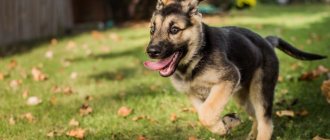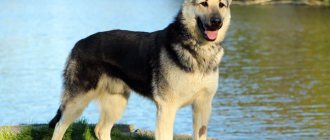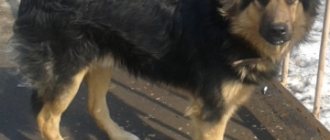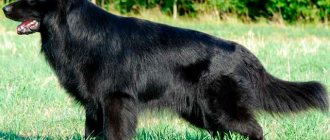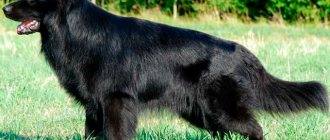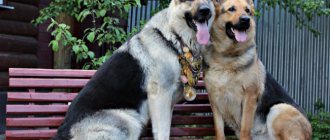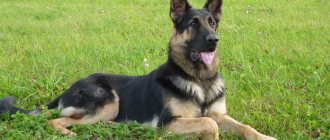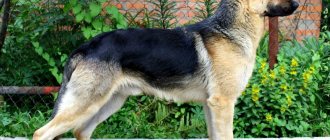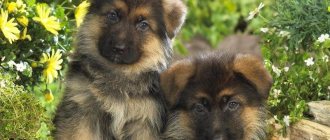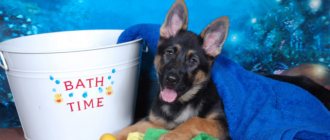Many people believe that the East European Shepherd (EVO) is the “twin brother” of the German Shepherd. Indeed, in appearance they are quite similar. This is not surprising - the Germans were actively involved in breeding this breed.
But did domestic breeders really just copy an existing breed? Of course not. The East European Shepherd is the result of painstaking work. She has become a symbol of service dog breeding and continues to be in demand among law enforcement officers. But what advantages and individual characteristics made her, without exaggeration, an ideal service dog?
Description of the East European Shepherd breed
Popularity 6th among 263 dog breeds
Lifespan:
12-13 years old
Breed group:
Service
Height:
males: 66-76 cm, females: 62-72 cm
Country of origin:
Russia
Average price:
15-20 thousand rubles
Weight:
males: 35-60 kg, females: 30-50 kg
Latest articles Cat health
Rabies vaccination for cats: choice of vaccine, necessity, schedule 01/22/2022 4 0 0
Selection and adaptation
TOP 20 best cat breeds for families with children 01/22/2022 25 0 0
FAQ
How many years do East European and German shepherd dogs live? — The average life expectancy of these two breeds is from 9 to 13 years.
Is there a purely black East European Shepherd or is this color typical only for “Germans”? - Yes. The colors of these breeds have many similarities. There are black VEOs and black “Germans”.
Is the white East European Shepherd recognized by the breed standard? - No. The existing VEO breed standard does not recognize this coloring of the dog.
Key facts
The East European Shepherd (abbreviated VEO) is the pride of Soviet and Russian breeders. The historical development of the breed was practically not affected by the human factor, which was able to protect dogs from a large number of diseases transmitted from generation to generation. Even abroad, many breeders prefer to buy Russian dogs - the characteristics of the East European Shepherd breed allow us to consider it the most promising in work.
A shepherd dog is, first and foremost, a service dog, which means it definitely needs to take OKD and ZKS courses. Only after they are completed can the owner be sure that his pet will not attack a passerby and will behave normally in society.
Owning a shepherd as a pet is a big mistake. This breed exists for work or sport. This animal cannot live in the conditions of a lap dog, and the description of the East European Shepherd breed emphasizes this.
Although these dogs are adapted to frost, they can easily be knocked down by dampness or drafts. You cannot leave your animal outside in rain or wet weather, even in a kennel. The exception is a heated kennel.
Shepherd dogs mature fully only by the age of 3. Until this time, you should be lenient about dog pranks. The dog may look like a huge and adult dog on the outside, but inside he is still a puppy.
The health of these service dogs is excellent - all thanks to small selection work. The average lifespan of an East European Shepherd is 11-13 years, which is a good length of time for large dogs.
Application of VEO
VEO is a universal service dog. She can handle any discipline, but she is best suited for security, guard, protective and search directions.
The East European Shepherd is used for:
- detection of drugs and explosives;
- defense;
- search and detention of criminals;
- protection of the territory.
Occasionally, VEO is trained as a guide dog. The characteristics of the breed include a balanced, calm temperament, which makes the dogs good caregivers. But in this matter they are superior to Labrador Retrievers.
Things are worse with sports. East European Shepherds are large, heavy, it is difficult for them to take hurdles, they move slower than the same BUT, collie, and Spitz. However, they are trained in canicross, weight-pulling, and agility.
History of the origin of the East European Shepherd
In the 30-50s of the last century, the USSR actively developed breeds of service dogs. Due to state necessity, East European Shepherds also appeared. Their main concern at that time was guard and escort service in the now well-known Gulag. However, in those days this, of course, was not advertised.
The breeding material was a German Shepherd. The best individuals were carefully selected and trained. Thanks to her, during that period the USSR developed several breeds of “superdogs”.
After the Second World War, there were almost no shepherd dogs left in domestic kennels, which meant that work on improving and developing the breed would have to start all over again. Already by the 60s, several breeds appeared at once, which showed excellent performance qualities and also had a pleasant appearance.
The camps and prisons had already disappeared by that time, but the work for these four-legged animals had not gone away. Now almost all of them were in the service of the Ministry of Internal Affairs, but some were used by ordinary people as guide dogs. Well, after such films as “Mukhtar” and “Border Dog Scarlet”, all the children dreamed of their own shepherd dog.
In 1964, appearance standards were drawn up for the breed, but not all world organizations recognized East European Shepherds as a full-fledged breed. Thus, FCI still considers this breed as a variety of German Shepherd.
Appearance of the East European Shepherd
General impression
By and large, the East European Shepherd is simply a Russian and somewhat enlarged version of the German Shepherd. However, externally it is quite easy to distinguish a German from a Russian Shepherd.
The first thing that will always catch your eye (even in a photo of an East European Shepherd and its brother) is that Easterners are much larger than Germans. The average male German Shepherd is the same in build as the not-largest female VEO.
According to the standard, the height of the East European Shepherd is 66-76 cm for males and 62-72 cm for females. The weight of the East European Shepherd always ranges from 35-60 kg and 30-50 kg, respectively.
Russian Shepherds have a straight back, unlike Germans, who have a strong slant visible to the naked eye. The legs are thicker and larger, causing dogs to move differently.
Head
The skull is flat, slightly widened between the ears, and there is a small groove along the forehead. The stop is smoothed, the brow ridges and the bump on the back of the head are not pronounced. The muzzle is narrow, but not pointed.
The nose is large and completely black. The eyes are regular ovals, set very wide, but slightly askew. The color of the iris is black or dark brown.
The ears are triangular, medium size, erect. Set high and quite wide. If the dog is relaxed, they can be slightly hung. In a wary dog they are raised straight up.
Neck
In relation to the back, it is set at an angle of 40-45 degrees. It widens slightly towards the shoulders. Purebred dogs have a muscular neck, without dewlap.
Torso
The shepherd's body is rectangular. The back is long, almost absolutely straight, strong. The loin is short, slightly convex. The line of the withers and croup are clearly visible. The chest is oval, reaching down to the elbows, with neat ribs. The belly is tucked in.
Forelegs
The front paws of a shepherd are straight and set parallel. The shoulder blades and shoulders are long and oblique. The angle of their articulation reaches 100 degrees. Elbows are pressed tightly to the sides. The pasterns are slightly inclined and springy.
Hind limbs
The hind legs look much more massive than the front legs due to the muscular thighs. The lower legs are slightly elongated, but not elongated. The paws are oval in shape, the toes are gathered into a ball, the pads are hard and completely black.
Movement
The shepherd moves with long strides, slightly waddling from side to side. In case of danger, it can almost instantly start running thanks to its strong hind limbs.
Wool
The coat consists of two layers: a soft, dense undercoat and a long, hard outer coat. The fur reaches its maximum length on the neck and hips, while it is short on the head and paws.
Color
Gray-red and black-gray colors of the East European Shepherd are allowed. There may also be light spots above the eyes, on the paws, on the cheekbones and under the tail. Zone-red coat color is not welcome.
Size
Males of the East European Shepherd grow up to 66-76 cm at the withers and weigh 35-60 kg. For females, these parameters look like this: 62-72 cm at the withers and 30-50 kg. The size of the East European Shepherd is incomparably larger than its German ancestors.
Character of the East European Shepherd
East European Shepherds are distinguished by their pragmatic and slightly arrogant disposition. They are never harsh or hot-tempered, which plays into their hands (or rather, into their paws) when they have to make important decisions at lightning speed.
The shepherd will not do anything without a clear goal. However, she will do everything to be useful to her owner. So, if you don’t need a reliable security guard or watchman, getting a shepherd is completely pointless - it will get bored without regular responsible tasks.
From childhood, Easterners do not like strangers, and this trait continues with them throughout their lives. However, they will not rush at people. This dog is ready to guard its owner 24 hours a day, but will act only when a threat really looms.
It is worth noting that only those dogs with which they have completed the OKD and ZKS course (general training course and protective guard service) behave this way. With young dogs that are still full of emotions, it is best to be careful. They still cannot distinguish between a tap on the shoulder and a blow, or a public place and a gang of hooligans - and can turn on their little defender at any moment.
A male East European Shepherd will never compete with the owner for the status of the main one. If a dog is raised correctly, then it calmly accepts the fact that the person in the family is in charge.
It is important to define the dog's role in the home immediately after the puppy arrives. If this has not been done, the dog will perceive its owner as spineless. This will quickly develop into disobedience, and therefore into an eternal confrontation between owner and pet.
In general, the character of the East European Shepherd is quite consistent. They even treat children kindly and calmly. She will also not touch pets that appeared in the house before or together with the shepherd.
But stray dogs and cats risk experiencing the full wrath of the East European Shepherd. Therefore, when going outside, always put on your dog not only a leash, but also a muzzle.
Theses
- This is a service breed, created for work and stress. Because of this, it is less suitable for living in an apartment, preferably a private house and a large yard. If the owner keeps the dog busy enough, he will be able to live in an apartment.
- VEOs are smart, but they only listen to those whom they consider to be higher in status than themselves.
- They are attached to one person and may completely ignore others.
- They shed a lot.
- They are not particularly suitable for families with children, as they avoid them and often do not understand them.
- They get along with other dogs, but can attack small animals.
Education and training
East European Shepherds are far from the best in terms of training. Yes, they are serious and result-oriented, but you shouldn’t expect outstanding victories from them. They think quickly, do not confuse reality with the game, and quickly understand the essence of explanations.
Shepherd dogs cope with the basic training course quite easily. This applies to both OKD and ZKS. But this is not a dog that, having learned a command once, will carry it with it through the years. Like people, VEOs learn and improve throughout their lives. This is the only way to not be afraid that the dog will behave inappropriately on the street or at a party.
As soon as you bring home an East European Shepherd puppy, you automatically agree that exercise and training will become your daily responsibility for the next few years. It is impossible to quit classes after one, two or six years - the eastern smart girl needs constant stress.
The owner for a shepherd is not the person who feeds it every day, but the one with whom it practices commands and goes through the training process. For this reason, you need to train your dog yourself, and not send it to institutions designed for this. Consultations with a dog handler are resorted to only in the most advanced cases, which are best avoided. Usually, the owner copes with the upbringing and training of the East European Shepherd on his own.
Up to two months, the dog must get used to its home, its owners, know where its place and food bowl are. This is called socialization and it is perhaps the most important aspect in training a dog.
From two months you can move on to mastering the simplest commands like “Ugh!”, “Sit!” and “Give me your paw!” In parallel with this, obedience lessons are also held, which will then become an excellent preparation for the OKD course. The most important thing a puppy must learn at this age is that in order to do something, you must first get permission from the owner.
The maximum benefit from training can be obtained only when the dog has fully accepted the fact that the person is authoritative for it. Under no circumstances should you allow your puppy to win during games together. The puppy will quickly regard this as weakness and will no longer obey you in everything.
At 4 months you can move on to learning more complex OKD commands. If you follow the right plan, then by the age of six months the puppy will be ready to pass all the standards and officially engage in protection. However, this does not mean that the learning ends there. You will have to spend the next six months improving and polishing all the skills you have acquired. Repetition for Shepherds is not a luxury, but a necessity.
For those who want to raise their dog to be an athlete, the international IPO (working dog obedience) course is perfect. It is worth understanding: although East European Shepherds are capable, they are quite difficult to complete any program.
ZKS will be allowed to you only if you successfully complete the OCD. It is required if you are a law enforcement or security officer and work with your dog. For others, taking this course is entirely voluntary.
Of course, when the need arises, even an untrained shepherd will protect its owner, but a well-trained representative of this breed will never turn your offender into mincemeat. The main mission of the animal is to scare away the opponent, and then catch up with him, drop him on his shoulder blades, demonstrating his own superiority over him. This is why we need a protective guard service course.
Looking for an East European Shepherd? Find your pet from 16 offers As a gift
Owner reviews
р8зб1
Advantages:
The breed itself, the character.
Flaws:
There is none of them.
In this review I will tell you about mine and my grandparents VEO. We will mainly talk about my Rex, but we will also talk about the breed. For a little over a month now, the puppy VEO has been living with my grandparents at their dacha. His name is Rex. We took the puppy from the breeders. When they brought him to the dacha, they immediately fed him. The breeders fed natural food. Rex is a dog with character: -on the first day he began to play and hunt for slippers; - sniffs everything; - plays pranks; -whines in the absence of owners; - a biting dog. On the Internet it is written: “VEOs are very playful and amenable to training.” And indeed, it showed. And here are our successes: - second day at home - responds to his name. - fifth day at home - mastered the commands “Come to me” and “Ugh!” He lives in an enclosure, he has a lot of things: - a bed; - bowls for food and water; -food; - toy (bone); -leash; - medicine for worms; - comb for dogs; -dog shampoo. They say that VEO's ears stand up to 4 months. Our Rex got up at 2.5. Rex is very funny, wonderful, I adore him and this breed! I recommend!!!
kissa07077
Advantages:
there is no creature more loyal
Flaws:
smell and fur
This is a working breed. loyal to only one owner. I personally prefer girls. they are more loyal. This breed learns quickly. excellent nanny for children. The security is also wow. I generally love large breeds. I like it just to do training.
Irene_ikr
Hi all!
We took our friend from breeders, titled parents and good characteristics!
As a child, I even tried to chew my shoes and dig (by the way, I never stopped digging holes in the yard) - but I succumbed to training very easily and literally the first time I realized what not to do!)
The dog of this breed is very smart and non-conflicting. Loves children - and tolerates all children's games. But he will put other dogs in their place if desired)
He loves winter very much - he sleeps in the snow, and only climbs into the kennel when it is very negative (about 25-30 degrees). In the summer, it often finds a place for itself under a thuja or under other decorative conifers, where it is cooler.
In general, I don’t know of a more wonderful and smarter dog) But of course, it is not recommended to keep such a dog in a cramped apartment - it needs its own yard
Antonmichai
Advantages:
An intelligent, versatile, loyal dog.
Flaws:
Large dimensions are not very suitable for an apartment.
Hi all! I want to share my opinion about the East European Shepherd dog breed. A dog of this breed guarded my parents’ house for 15 years! Dogs of this breed are very smart and easy to train. She can be a guide dog, serve in the police, guard prisoners, be a companion dog, is loyal to all family members, is infinitely devoted to her owner, treats children well, but is distrustful of strangers. For those who want to bring this breed of dog into an apartment, I would not recommend taking it; you will have too much hair, plus an unpleasant dog smell, and the dimensions of this dog are not small. So if you live in a private home and need a guard (a versatile four-legged friend) then this breed is for you.
Tutova
I was given a 2 week old puppy VEO when I was 12 years old. By that time, I was a “walking encyclopedia” on raising and training dogs; the topic of dogs was incredibly interesting to me. I’ll say right away that at that time we lived in a village, that is, there is a plot of land next to the house. Of course, for the first month I kept my baby at home... I must say that he behaved very intelligently, he didn’t tear wallpaper or slippers, didn’t whine, so calmly and importantly watched from the side what was going on around him)) Then they built an enclosure for Rexik, a wooden one, There are, as it were, 2 sections inside: a small one, where there is a dog house, and a second one - just space for the dog to walk around the enclosure, where his bowls and cups were, and a leash and muzzle hung. At first, to get the dog used to it, I left him for an hour, then more... eventually he got used to it and stopped whining. As for training and education... you need to start EDUCATION (namely, the formation of an adequate attitude in the dog directly towards you, other people, dogs and animals) IMMEDIATELY. Then it will be much harder to do it. And I started training when he was 2 months old, when Rex got a little stronger and was able to focus his attention on commands. Our learning process lasted until he was a year old... we started with the simplest: give paw, sit, lie down, voice, then a command nearby, then a snake, wait, fetch, search for objects by smell, search for a person by smell, barrier, well... fas:))) I must say, the dog learns with great interest and attention, masters almost everything the first or second time... for us, the difficulty was finding a person. I would also like to warn you: I advise you to start learning how to take hurdles after 7-8 months, when the joints and ligaments become stronger. I had just such a mistake, he was 5 months old and jumped over a small obstacle, but got caught with his paw and ended up getting dislocated ((As for the dog’s disposition..VEOs are different from the Germans in that they are calmer and more balanced, but, again, training and upbringing decide a lot. Mine is absolutely loyal to people, with other dogs he is quite friendly and playful, although he hates cats... but this is normal for a dog)) About walks: no matter how friendly your dog is, ALWAYS wear a muzzle!! !My Rex has a leather one, he’s already used to it, he doesn’t try to take it off... This is what I’m saying: imagine a huge dog walking calmly down the street, albeit on a leash. People are afraid. Therefore, at least for the sake of respect for others, accustom your dog to a muzzle. Now my Rexik is already 10 years old. He is no longer so playful and energetic, he gets tired quickly, but for me he is the best dog, a reliable friend who brings joy)) I remember him with great warmth and nostalgia as a puppy, because then our friendship was just beginning) Who is ready to devote time, effort, give a piece of your heart to this wonderful dog, I advise you to buy it! PS I apologize for the photos, others were left on the old computer.
Video
Health and Diseases of the East European Shepherd Dog
Possible diseases
Although East European Shepherds have good health, they still have a predisposition to certain diseases. Among them, for example, intestinal volvulus and gastric obstruction, due to which the diet and portions for this breed are strictly limited.
By a certain age, the vast majority of shepherd dogs begin to have joint problems. This can be either dysplasia due to excess weight or physical inactivity, or arthritis. From their ancestors, Easterners also received eye problems, in particular, entropion and glaucoma.
All of the listed ailments will not cause discomfort to your pet if you carry out regular examinations and tests. As you get older, the number of preventive examinations at the veterinarian increases.
Reproductive health
Estrus in East European Shepherds begins only at 13-14 months of life and can last up to 24-28 days. At this time, it is worth paying special attention to the dog’s behavior. Sometimes a nervous bitch will bite an animal that approaches her, whether it is your pet or a street cat that runs past during a walk.
Pregnancy in females is quite easy, but the first birth can be difficult. And although it is recommended to breed dogs only from 2-3 years of age, the first litter is often defective or few in number.
On average, East European Shepherd females give birth to from 7 to 11 puppies, but the dog can give birth to only 3-5 babies for the first time.
Features of feeding and diet
The diet of this breed is not abundant. The dog will be quite satisfied with the usual menu of meat and cereals or premium food. But even here there are several rules that must be followed:
- raw meat can be given to your dog only when you know for sure that it is fresh; if you are not sure, then it is better to boil it or scald it with boiling water;
- Never feed your dog leftover food or give it food from the table;
- the amount of fruits and vegetables in the diet can be reduced in favor of meat or cereals, since the shepherd dog does not digest plant foods well;
- porridge from several types of cereals, nuts and dried fruits is a waste of your money, they have almost no benefit; buckwheat, rice, and pearl barley porridge are enough for a shepherd dog.
It is almost impossible to balance the diet of homemade food, so veterinarians often advise owners to add various supplements and dietary supplements from a veterinary pharmacy to their food. For the East European Shepherd, in particular, a composition that strengthens the joints will be useful.
Be careful, because an overdose of such substances is dangerous. Consult your veterinarian before purchasing any medications. Your dog may not need them at all.
Puppies are weaned from their mother at the age of 2 months, so they still need five meals a day. From the fourth to the eighth month you need to feed the puppy four times a day, from 8 to 12 months - 3 times.
You can switch your dog to two meals a day from the age of one and a half years, but even for the first six months you need to give the dog a light snack between meals.
How to care
An East European Shepherd living in an apartment sheds constantly. If you are not ready to devote a lot of time to grooming and cleaning the house, choose another breed. The thick coat with undercoat is brushed at least twice a week to keep it looking beautiful and healthy. During seasonal molting, this will have to be done 4 to 5 times a week. Animals living in an enclosure undergo a combing procedure every day.
You need to bathe rarely so as not to disturb the natural lubrication that protects the coat. This should be done only if the shepherd dog is very dirty, and after a walk it is enough to wash the pet’s paws. For bathing, use only special soft pet shampoos with a gentle cleansing effect. This breed does not need to be taken to a groomer; the shepherd's coat does not mat and does not need to be trimmed.
VEO puppies are taught to brush their teeth, ears and eyes, as well as trim their nails from a very early age. When the animal grows up and matures, it will be difficult to persuade it. Smart animals quickly understand what the owner wants from them and do not interfere with the procedures. After going outside, you need to inspect your dog for ticks; you also need to teach the animal to do this from infancy.
VEO is a working breed of dog that needs daily physical and mental exercise. You can train dogs in a special dog training school, but it is better to do it yourself under the guidance of experienced trainers. These shepherds consider the one who trains them to be the owner. Animals obey this man unconditionally and carry out all his commands.
Care and maintenance
When deciding to bring an East European Shepherd into your home, you must understand that it will need a lot of free space. The dog's sleeping place should not be in a dark corner or under a table. It should be quiet around him.
If a puppy is constantly disturbed from sleeping by the screams of children or members of the household stumbling over his bedding, this makes him nervous, which means there is a high probability that he will grow into an uncontrollable, wild dog. The bedding should not be too soft or too hard, so as not to injure the dog’s joints. It’s better to buy a bowl on a special tripod so that it is higher.
Ideally, if you have the opportunity to keep your dog in an enclosure with a warm winter booth. Moreover, the kennel should not be a cramped kennel, but a spacious house where the dog can lie down, curled up or stretched out to its full height. An excellent replacement for bedding would be warm, dry hay. It needs to be changed periodically, and the dog’s home must also be treated for parasites.
If your pet prefers to lie outside rather than in a kennel, this is a sign that it’s time to disinfect. It is not necessary to fill the box with hay in the summer, but then lay a soft, lint-free rug in it. The most important thing is that the dog should not be chained. Even if it is long and even if it is light, this only develops the animal’s distrust of you.
Shepherds are active and strong dogs, which means they need constant physical activity. Until 8 months of age, physical activity is prohibited for the puppy - short walks near the house and swimming in the nearest body of water are sufficient if it is warm outside. There is no need to wear any weights for a home guard - they are useless.
Walking an adult dog on a leash is not enough. If you have already taken your shepherd outside, then let him run around as much as he can. Usually an hour or two is enough for her. During this time, you can do strength exercises, such as towing a load, jogging behind a bicycle, or swimming.
However, all this is allowed only if the dog is completely healthy. Sick dogs should not engage in any sports or receive additional exercise. It is also impossible to practice jumping with VEO until she is a year old, since her joints are not yet fully formed.
In general, the care and maintenance of the East European Shepherd is based on active exercise outside the home and simple but good feeding. The animal should be combed during shedding, and the whole animal should be bathed only if it gets dirty.
What to feed
Avid dog lovers and experienced dog handlers know the saying: “The breed enters through the mouth.” The external data or exterior of the VEO puppy, the pet’s health, growth and full development depend on proper feeding. Feeding the puppy is consistent with the baby's growth rate.
A puppy settling into a new living space, getting used to its owner, experiences stress. In the initial days, it is better to adhere to the feeding regime that was practiced by the breeders running the nursery. Even food and feed should be selected with an eye to feeding in the nursery. As a rule, breeders are happy to advise the owner on emerging issues.
The puppy’s diet depends on the age periods associated with the energy costs of the growing body. There are two known types of feeding: natural products and ready-made factory feeds. In the first case, the owners will need to ensure that many foods are included in the diet and that the diet remains balanced. In the second, everything has already been thought out for the owners. Industrial quality food already contains the nutrients, vitamins and minerals your puppy needs.
- The one-month-old puppy VEO needs to be fed 6 times a day.
- The VEO puppy, 2 months old, receives 5 meals a day.
- At three months of age, the puppy is fed 4 times.
- A six-month-old puppy is taught to eat 2 meals a day.
If the puppy is active, he is trained or kept in harsh conditions (outdoors in an enclosure, even in winter), the need for food increases due to increased energy costs. But the diet of the “Eastern” is supposed to be balanced, able to replace the loss of energy after exercise and exercise. From now on, nutritious food is available to all breeds.
If, when deciding what to feed your East European Shepherd puppies, you decide to opt for dry food, do not forget to make sure there is fresh water in the animal’s bowl. Food is chosen taking into account the age and breed of the pet. Don’t forget to change your diet, reduce the number of feedings, and the size of portions as your dog gets older.
It is possible to feed a mature East European Shepherd with dry food or prefer a diet with products of natural origin. It is better to feed an adult dog twice a day.
Regardless of the method you choose, monitor and supplement your dog's diet with vitamins and mineral supplements. If your work schedule leaves little free time, it is better to prefer a diet based on dry food, selected according to the dog’s structural features. The health of your pet depends on proper nutrition. Representatives of the species are predisposed to diseases:
- allergy;
- joint disease;
- If you eat improperly, stomach problems often occur.
To protect your dog from diseases, introduce the correct daily routine, with obligatory long walks and physical activity. Exclude from your diet:
- Sweets. It is better not to give your pet any chocolates, sweets or other goodies. Give your dog a piece of cheese as a treat, or buy special sweets for dogs at the pet store.
- Fat meat. Meat containing excess fat is difficult to digest. It is better to replace fatty pork with veal or boiled beef.
Tips for choosing a puppy
First of all, you should get to know the mother of your future pet and evaluate her character - in most cases it is passed on to puppies. A bad sign may be that the breeder keeps the dog on a leash or does not let it out of the crate. A shepherd dog may bark at you in defense of its offspring, but it will never take drastic measures.
If the bitch growls at you and tries to bite you, you definitely shouldn’t take a puppy from this kennel. Do you really want a dog that will behave the same way 90% of the time?
Find out in more detail about the merits of parents. Do they have OKD and ZKS diplomas? If so, then the puppy will definitely repeat their successes. If you need a shepherd as a pet, pay attention to how the bitch treats her children.
Avoid the idea of adopting an older puppy if you are afraid that you will not be able to handle its upbringing. It’s great if the breeder has already given the East European Shepherd puppies the necessary vaccinations and taught them basic commands, but the older the dog you pick up from the kennel, the more difficult it is for it to make contact with you.
Métis
VEO mestizos may retain their breed traits, but you should not expect that non-purebred “Easterns” will be ideal watchdogs and will be easy to train. Most often you can find a mestizo - a cross between a German and an East European shepherd. A hybrid of two breeds with a similar exterior and character will most likely not bring unexpected unpleasant surprises.
Other hybrids:
- mixed breed of husky and East European Shepherd;
- a cross between a husky dog and a VEO dog;
- a cross between an East European Shepherd girl and a Labrador boy;
- a hybrid of a mongrel and a VEO.
As a result of such hybrid matings, we can get charming pets that claim exclusively to be pets.
